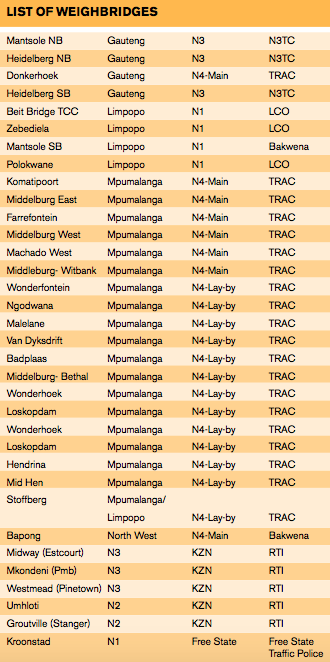No heavy vehicles, no heavy damage. That is the motto of SANRAL’s weighbridges, used to determine the static weight of a heavy motor vehicle.
Uncontrolled vehicle overloading has been proven to result in the accelerated deterioration of roads, as well as increasing the risks of crashes. In crashes SANRAL’s Northern Region alone, which comprises Gauteng, North West, Limpopo and Mpumalanga, there are 15 Load Control Centres (LCC) that operate 24 hours a day, 7 days a week, and 11 lay-bye sites that are operated by means of Mobile Load Control Units.
Once a vehicle has been found to be overloaded it is directed into a holding yard. The load has to be corrected within the legal limits. No load is allowed to be left at the facility. Only after the load is corrected and the vehicle is re-weighed will it be released to continue on its journey.
The number of vehicles weighed varies between the various centres – from about 150 to 500 per day. In 2014, approximately two million vehicle weighs were conducted at SANRAL LCCs.
The existence of weighbridges along the network has had a positive effect. When SANRAL started operating the LCCs on the N4 the overloading percentage was 28%. It is currently below 5%. The average overloading percentage is 4.5%.
We asked SANRAL’s Louw Kannemeyer a few questions about weighbridges and their importance:
Heavy vehicles that do not comply with the load design specifications of the suspension, brakes, tyres and steering of vehicles are a safety hazard to all road users. In addition, overloaded heavy vehicles cause exponentially more damage to the road structure, resulting in accelerated deterioration and increased maintenance costs. As an example, a single 9-ton axle that is 25% overloaded causes 155% more damage to the pavement.
SANRAL continues to support the road transport management system (RTMS), which is a Department of Transport strategy to promote self-regulation in the road freight industry. RTMS accreditation means that truck fleet owners must continually demonstrate that they load their vehicles correctly and securely, ensure that their trucks are roadworthy and that their drivers are healthy and well rested.
The benefits of RTMS management are reduced road damage, promotion of road safety and reduction of road transport costs. SANRAL supports this initiative with data indicating that member organisations seldom overload and are involved in fewer accidents.
SANRAL also supports the “smart trucks” demonstration project. This is research being conducted to ascertain the benefits of allowing vehicles that meet stringent dynamic design criteria to carry heavier loads, while maintaining all loading criteria except for the maximum legal load of 56 tonnes.
In terms of road maintenance, every kilometre of the national road network has service providers appointed that are responsible for all the day to day responsive maintenance requirements that need to be performed, this includes cutting grass, cleaning drains, litter collection, repairing of damaged road signs, repairing of potholes, accident scene clean-up, etc. The impact of this preventative maintenance approach of SANRAL should be clearly visible to road users when travelling on the national road network.




